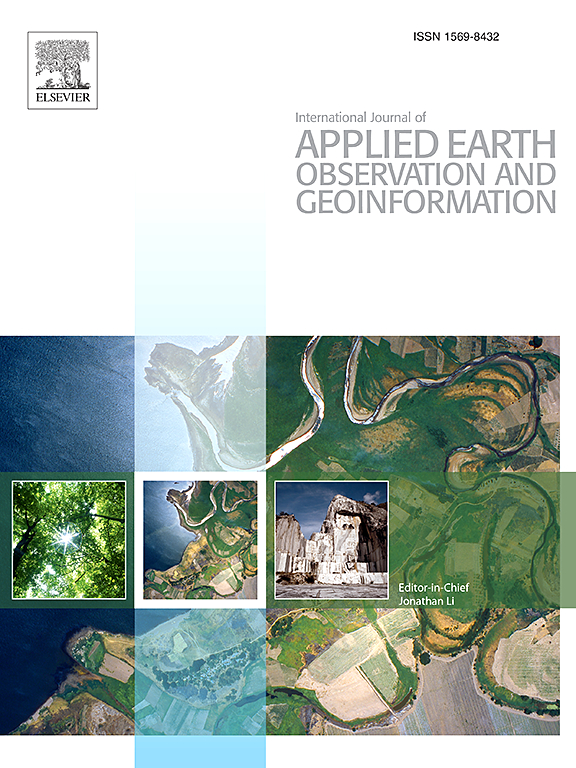基于知识蒸馏的资源受限设备空中火灾实时探测
IF 7.6
Q1 REMOTE SENSING
International journal of applied earth observation and geoinformation : ITC journal
Pub Date : 2025-07-15
DOI:10.1016/j.jag.2025.104665
引用次数: 0
摘要
野火灾害造成严重的环境退化、人员损失和经济损失。为了减轻这些严重影响,早期火灾探测和预警系统至关重要。目前的系统主要依赖于固定的闭路电视摄像机,视野有限,限制了它们在大型户外环境中的有效性。智能火灾探测与遥感的融合提高了覆盖范围和机动性,能够在偏远和具有挑战性的地区进行监控。现有的方法主要利用卷积神经网络和视觉变换模型。虽然这些架构在火灾探测方面提供了高精度,但它们的计算复杂性限制了无人机等边缘设备的实时性能。在我们的工作中,我们提出了一个基于MobileViT-S的轻量级火灾探测模型,该模型通过从一个更强大的教师模型中提取知识进行压缩。烧蚀研究强调了教师模型和所选择的蒸馏技术对模型性能改进的影响。我们使用Grad-CAM生成激活图可视化,以确认模型专注于相关火灾区域的能力。该模型的高精度和高效率使其非常适合部署在卫星、无人机和物联网设备上,以进行有效的火灾探测。在常见的火灾基准测试中,我们的模型在保持紧凑的模型尺寸的同时,比最先进的模型高出0.44%,2.00%。我们的模型在现有作品中提供了最高的处理速度,在资源受限的设备上实现了实时性能。本文章由计算机程序翻译,如有差异,请以英文原文为准。
Real-time aerial fire detection on resource-constrained devices using knowledge distillation
Wildfire catastrophes cause significant environmental degradation, human losses, and financial damage. To mitigate these severe impacts, early fire detection and warning systems are crucial. Current systems rely primarily on fixed CCTV cameras with a limited field of view, restricting their effectiveness in large outdoor environments. The fusion of intelligent fire detection with remote sensing improves coverage and mobility, enabling monitoring in remote and challenging areas. Existing approaches predominantly utilize convolutional neural networks and vision transformer models. While these architectures provide high accuracy in fire detection, their computational complexity limits real-time performance on edge devices such as UAVs. In our work, we present a lightweight fire detection model based on MobileViT-S, compressed through the distillation of knowledge from a stronger teacher model. The ablation study highlights the impact of a teacher model and the chosen distillation technique on the model’s performance improvement. We generate activation map visualizations using Grad-CAM to confirm the model’s ability to focus on relevant fire regions. The high accuracy and efficiency of the proposed model make it well-suited for deployment on satellites, UAVs, and IoT devices for effective fire detection. Experiments on common fire benchmarks demonstrate that our model surpasses the state-of-the-art model by 0.44%, 2.00% while maintaining a compact model size. Our model delivers the highest processing speed among existing works, achieving real-time performance on resource-constrained devices.
求助全文
通过发布文献求助,成功后即可免费获取论文全文。
去求助
来源期刊

International journal of applied earth observation and geoinformation : ITC journal
Global and Planetary Change, Management, Monitoring, Policy and Law, Earth-Surface Processes, Computers in Earth Sciences
CiteScore
12.00
自引率
0.00%
发文量
0
审稿时长
77 days
期刊介绍:
The International Journal of Applied Earth Observation and Geoinformation publishes original papers that utilize earth observation data for natural resource and environmental inventory and management. These data primarily originate from remote sensing platforms, including satellites and aircraft, supplemented by surface and subsurface measurements. Addressing natural resources such as forests, agricultural land, soils, and water, as well as environmental concerns like biodiversity, land degradation, and hazards, the journal explores conceptual and data-driven approaches. It covers geoinformation themes like capturing, databasing, visualization, interpretation, data quality, and spatial uncertainty.
 求助内容:
求助内容: 应助结果提醒方式:
应助结果提醒方式:


